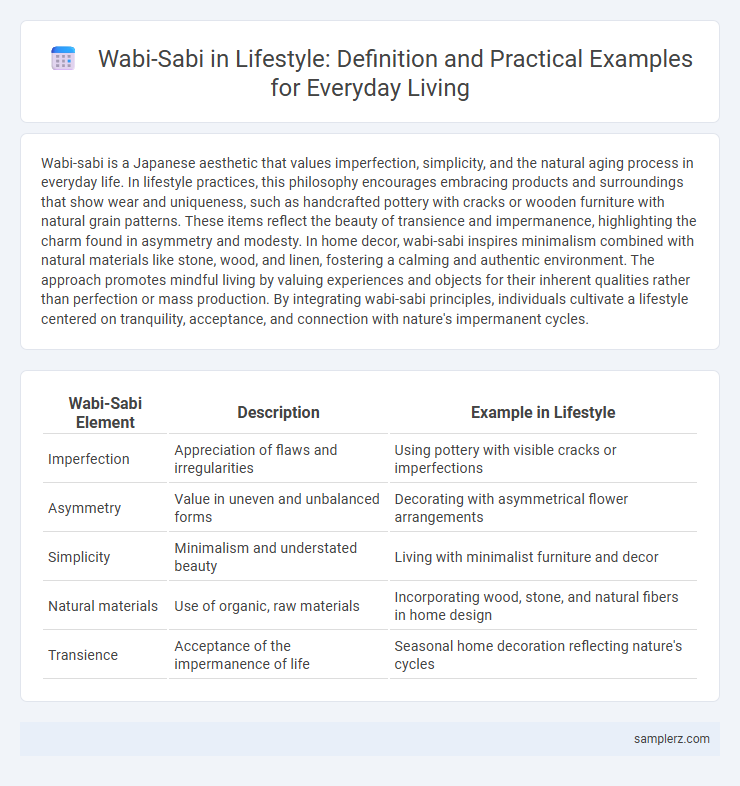Wabi-sabi is a Japanese aesthetic that values imperfection, simplicity, and the natural aging process in everyday life. In lifestyle practices, this philosophy encourages embracing products and surroundings that show wear and uniqueness, such as handcrafted pottery with cracks or wooden furniture with natural grain patterns. These items reflect the beauty of transience and impermanence, highlighting the charm found in asymmetry and modesty. In home decor, wabi-sabi inspires minimalism combined with natural materials like stone, wood, and linen, fostering a calming and authentic environment. The approach promotes mindful living by valuing experiences and objects for their inherent qualities rather than perfection or mass production. By integrating wabi-sabi principles, individuals cultivate a lifestyle centered on tranquility, acceptance, and connection with nature's impermanent cycles.
Table of Comparison
| Wabi-Sabi Element | Description | Example in Lifestyle |
|---|---|---|
| Imperfection | Appreciation of flaws and irregularities | Using pottery with visible cracks or imperfections |
| Asymmetry | Value in uneven and unbalanced forms | Decorating with asymmetrical flower arrangements |
| Simplicity | Minimalism and understated beauty | Living with minimalist furniture and decor |
| Natural materials | Use of organic, raw materials | Incorporating wood, stone, and natural fibers in home design |
| Transience | Acceptance of the impermanence of life | Seasonal home decoration reflecting nature's cycles |
Embracing Imperfection: Wabi-Sabi in Everyday Living
Wabi-sabi in everyday living is exemplified by embracing the beauty of imperfection through natural materials like weathered wood and handmade pottery, which highlight the passage of time. This lifestyle values simplicity, authenticity, and the acceptance of transience, fostering mindfulness and contentment. Incorporating wabi-sabi encourages letting go of perfectionism and finding peace in the imperfect and incomplete aspects of daily life.
Natural Materials in Home Décor: Wabi-Sabi Choices
Incorporating wabi-sabi in lifestyle emphasizes the beauty of natural materials like weathered wood, clay pottery, and linen fabrics in home decor, which highlight imperfection and authenticity. These elements create a calming environment by celebrating organic textures and irregularities, fostering a sense of warmth and timelessness. Choosing handcrafted items with visible craftsmanship supports sustainability and deepens the connection to nature within living spaces.
Simplicity and Serenity: Designing Wabi-Sabi Spaces
Wabi-sabi lifestyle embraces simplicity and serenity by incorporating natural materials, muted colors, and minimalist design that highlight imperfection and transience. Furniture made from raw wood, stone, and unpolished ceramics creates a calming environment that fosters mindfulness and relaxation. This aesthetic encourages decluttering and choosing quality over quantity, enhancing the sense of peacefulness in everyday living spaces.
Mindful Consumption: Wabi-Sabi Shopping Habits
Wabi-sabi-inspired lifestyles emphasize mindful consumption by valuing quality over quantity and embracing imperfection in everyday items. Choosing handcrafted, sustainable products with natural wear fosters appreciation for the beauty of impermanence and simplicity. This approach encourages intentional purchasing that prioritizes durability, ethical sourcing, and emotional connection to belongings.
Slow Living: The Wabi-Sabi Approach to Time
Embracing the wabi-sabi philosophy in slow living encourages mindfulness by appreciating each moment's imperfection and impermanence. This approach values natural rhythms, prioritizing quality over quantity in daily activities and fostering deeper connections with oneself and the environment. Incorporating wabi-sabi into time management promotes patience, reduces stress, and cultivates a meaningful, balanced lifestyle centered around simplicity and authenticity.
Cherishing the Old: Wabi-Sabi in Vintage and Repaired Items
Wabi-sabi in lifestyle embraces the beauty of imperfection by cherishing vintage and repaired items that tell stories through their wear and history. This aesthetic values the authenticity found in weathered textures, faded colors, and handcrafted repairs, highlighting the passage of time rather than seeking flawlessness. Integrating these elements into daily living fosters appreciation for sustainability and mindfulness, reconnecting individuals with a slower, more intentional way of life.
Minimalism with Soul: Wabi-Sabi in Decluttering
Embracing wabi-sabi in decluttering means cherishing imperfections and valuing simplicity, turning minimalism into a soulful practice rather than mere functionality. This lifestyle shift encourages keeping items with personal history and natural wear, reflecting authenticity and transient beauty. Minimalism infused with wabi-sabi transforms spaces into calming environments that celebrate impermanence and genuine connection with belongings.
Nature’s Influence: Bringing the Outdoors In
Incorporating wabi-sabi into lifestyle emphasizes embracing nature's influence by integrating raw, organic materials like driftwood, stone, and handmade ceramics into indoor spaces. This aesthetic values imperfection and transience, celebrating weathered textures and natural color palettes that evoke tranquility and simplicity. Bringing the outdoors in creates a harmonious environment that nurtures mindfulness and connection with the natural world.
Handcrafted Touches: Celebrating Artisan Goods
Incorporating wabi-sabi into lifestyle embraces handcrafted touches that highlight the beauty of imperfection found in artisan goods. Handmade ceramics with asymmetrical shapes, natural textures, and subtle glaze variations embody the philosophy's appreciation for authenticity and transience. Celebrating these unique artisan creations fosters a deeper connection to the slow, mindful process behind each piece.
Finding Beauty in Transience: Seasonal Wabi-Sabi Rituals
Embracing wabi-sabi in lifestyle involves adopting seasonal rituals that celebrate impermanence and natural cycles, such as enjoying the fleeting beauty of cherry blossoms in spring or the rustic charm of autumn leaves. These practices highlight the acceptance of aging and decay, encouraging mindfulness and gratitude for life's transient moments. Incorporating seasonal wabi-sabi rituals fosters a deeper connection to nature and personal well-being through appreciating simplicity and imperfection.

example of wabi-sabi in lifestyle Infographic
 samplerz.com
samplerz.com